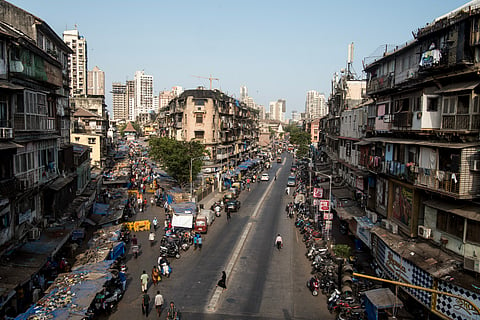
- Destinations
- Experiences
- Stay
- What's new
- Celebrating People
- Responsible Tourism
- CampaignsCampaigns
- Subscribe
- Buy Now

Bhendi Bazaar, tucked away in the centre of South Mumbai, has long been a distinctive hub of trade, culture, and close-knit communal life. However, this ancient district has suffered numerous difficulties over the years, such as congested streets, poorly designed architecture and navigation, outdated infrastructure, and declining living standards.
The Saifee Burhani Upliftment Trust (SBUT) responded by starting a large-scale reconstruction project in 2009 with the goal of revitalising the neighbourhood while protecting its unique history.
Outlook Traveller goes back in time to trace what has occurred at this unique neighbourhood, which is a significant part of Bombay's imagination, throughout the years and how it has changed as a result of numerous schemes for transformation and wagers made on it.
The origins of Bhendi Bazaar goes back to the British colonial period when it served as a residential complex for workers employed in Bombay's bustling trade activity. Over time, the area evolved into a densely packed neighbourhood, whose distinct character lay in narrow alleys and ageing, dilapidated buildings, not much unlike Old Delhi and other similar neighbourhoods.
But how did Bhendi Bazaar get its name? The unique name seems to have originated from the British referring to the area as being "behind the bazaar," and not as much the popular vegetable bhindi or ladyfinger in Hindi. The locals adapted it into their language and stuck with Bhendi Bazaar.
As trade grew and Bombay [now Mumbai] solidified its reputation as the city of jobs and dreams, the neighbourhood came to be a melting pot of cultures with a significant presence of the Dawoodi Bohra community, known for their entrepreneurial spirit and communal harmony.
Acknowledging the urgent need for revitalisation, SBUT launched a comprehensive 16.5-acre rehabilitation plan that included 1,250 enterprises, 3,200 people, and more than 250 deteriorating buildings. His Holiness Dr. Syedna Mohammed Burhanuddin, 52nd Dai al-Mutlaq, conceived the project with the intention of improving the quality of life for locals while conserving the region's traditional heritage.
The construction of the Al Sa'adah Towers, two high-rise structures with 36 and 41 stories, marked the project's first phase's completion. These towers, which were finished in 2019, now house 128 businesses and 610 families while offering inhabitants better living conditions, modern conveniences and increased safety features. About 13 dangerous buildings were also replaced marking a major turning point in the project's development.
Building on the first phase's success, SBUT started Phase 2, which was centred on building the An-Nasr and Al-Ezz towers. These 53-story towers, which will replace 23 outdated and decaying structures, are intended to house about 1,250 families and over 270 companies. Specifically, the Al-Ezz skyscraper is located on Mohammed Ali Road, a major local highway.
The rebuilding project's focus on sustainability is one of its pillars. The new structures include solar-powered lighting in public spaces, rainfall collection systems that cut water use by 35–50 per cent, and sewage treatment plants that recycle wastewater for non-potable applications. Furthermore, SBUT's dedication to ecologically conscious development in Bhendi Bazaar is demonstrated by the use of waste segregation systems and the selection of native tree types that use less water.
By using a participatory approach, SBUT has tried to ensure that locals are included in every step of the redevelopment process. Families were given transit accommodations close to their original homes during construction, and they were given free ownership of their new homes when it was finished. In addition to minimising displacement, this tactic maintained the social cohesion of the neighbourhood.
The initiative aims to preserve the region's historic assets while also updating the infrastructure. The restoration of the Saifee Masjid, which was first constructed in 1926, is a noteworthy example. The mosque is a spiritual hub for the neighbourhood and has been restored with contemporary amenities while maintaining its ancient charm.
Economic revitalisation has also been sparked by the reconstruction. Modern commercial spaces, better infrastructure, and more foot traffic are now advantages for businesses that previously functioned in claustrophobic and unsanitary conditions. One long-standing local business, Tawakkal Sweets, has seen a strong resurgence and attributes its success to the better environment made possible by the redevelopment.
As the renovation of Bhendi Bazaar continues, it serves as an example of inclusive and sustainable urban rejuvenation in India. The project demonstrates a comprehensive approach to urban development by striking a balance between contemporary infrastructure, cultural preservation, and community involvement. When finished, it hopes to improve locals' quality of life and establish a model for similar projects nationwide.
